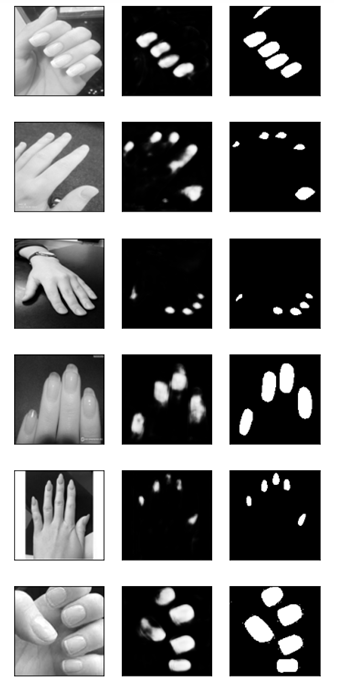0.はじめに
読んでから数ヶ月経つと『ゼロから作るDeep Learning 3』の内容も頭から綺麗サッパリ消え去りました。
というわけで復習を兼ねて、DeZeroでセマンティックセグメンテーションをしてみたいと思います。
windows10/gpuはgeforce gtx1060(6G)
使用しているのはこちら
python 3.7.13
DeZero 0.0.13
numpy 1.21.5
cupy 6.0.0
pillow 9.0.1
matplotlib 3.5.1
今回のnotebookは以下のリンク先で見られます。
https://github.com/takanashiyoruyoru/dezero_sample/blob/main/dezero_Semantic_Segmentation.ipynb
1. DeZeroの機能拡張
まずはDeZeroにないupsamplingとconcatの機能を作成します。
upsamplingは、「N * C * X * Y 」のデータを「N * C * 2X * 2Y 」にして、解像度を2倍にします。
forwardのときは、X軸, Y軸方向に2回、同じデータを繰り返します。
backwardのときは、4つの塊ごとに合計します。

class Up(Function):
def __init__(self):
super().__init__()
def forward(self, x):
return x.repeat(2, axis=2).repeat(2, axis=3)
def backward(self, gy):
return gy[:, :, ::2, ::2] + gy[:, :, 1::2, ::2]\
+ gy[:, :, ::2, 1::2] + gy[:, :, 1::2, 1::2]
forwardではcupy/numpyのrepeatを使用しています。
backwardではスライス機能で表現しています。
このUpのクラスでは解像度2倍にする機能しかありませんが、今回はこれで事足ります。
次にconcatでは, 「N * C1 * X * Y 」のデータと「N * C2 * X * Y 」のデータを組み合わせて「N * (C1 + C2) * X * Y 」にします。
class Concat(Function):
def forward(self, x1, x2):
xp = cuda.get_array_module(x1)
#self.x1_len = xp.shape(x1)[1]
self.x1_len = x1.shape[1]
return xp.concatenate([x1, x2], axis=1)
def backward(self, gy):
gy_1 = gy[:, :self.x1_len, :, :]
gy_2 = gy[:, self.x1_len:, :, :]
return gy_1, gy_2
def concat(x1, x2):
"""
Join two Variables along axis 1.
The shapes of x1 and x2 must be the same, except in the axis 1 direction.
Parameters
----------
x1 : Variable
x2 : Variable
The axis along which the Variables will be joined.
"""
return Concat()(x1, x2)
forwardのときに, C1の大きさ(x1.shape[1])を記憶しておくのがポイントです。
2. ネットワークの作成
ここではU-net風のネットワークを組んでみます。
U-netについては様々な文献で多くが語られていると思うので、あまり説明はしません。
今回は爪 or 爪でない を判断するネットワークを作成したいので、最後はsigmoid関数です。
class Net(Model):
def __init__(self):
super().__init__()
self.conv_0 = L.Conv2d(32, kernel_size=3, stride=1, pad=1)
self.conv_01 = L.Conv2d(32, kernel_size=3, stride=1, pad=1)
self.conv_1 = L.Conv2d(64, kernel_size=5, stride=1, pad=2)
self.conv_2 = L.Conv2d(128, kernel_size=5, stride=1, pad=2)
self.conv_3 = L.Conv2d(128, kernel_size=5, stride=1, pad=2)
self.conv_4 = L.Conv2d(128, kernel_size=3, stride=1, pad=1)
self.conv_5 = L.Conv2d(64, kernel_size=3, stride=1, pad=1)
self.conv_6 = L.Conv2d(32, kernel_size=3, stride=1, pad=1)
self.conv_head0 = L.Conv2d(32, kernel_size=3, stride=1, pad=1)
self.conv_head1 = L.Conv2d(1, kernel_size=3, stride=1, pad=1)
self.up4 = Up()
self.up5 = Up()
self.up6 = Up()
self.bn_0 = L.BatchNorm()
self.bn_01 = L.BatchNorm()
self.bn_1 = L.BatchNorm()
self.bn_2 = L.BatchNorm()
self.bn_3 = L.BatchNorm()
self.bn_4 = L.BatchNorm()
self.bn_5 = L.BatchNorm()
self.bn_6 = L.BatchNorm()
self.bn_head = L.BatchNorm()
def forward(self, x0):
x0 = F.relu(self.bn_0(self.conv_0(x0)))
x0 = F.relu(self.bn_01(self.conv_01(x0)))
x1 = F.relu(self.bn_1(self.conv_1(F.pooling(x0, 2, 2))))
x2 = F.relu(self.bn_2(self.conv_2(F.pooling(x1, 2, 2))))
x3 = F.relu(self.bn_3(self.conv_3(F.pooling(x2, 2, 2))))
x4 = F.relu(self.bn_4(self.conv_4(self.up4(x3))))
x4 = concat(x2, x4)
x5 = F.relu(self.bn_5(self.conv_5(self.up5(x4))))
x5 = concat(x1, x5)
x6 = F.relu(self.bn_6(self.conv_6(self.up6(x5))))
x6 = concat(x0, x6)
x = F.relu(self.bn_head(self.conv_head0(x6)))
x = F.sigmoid(self.conv_head1(x))
return x
3.学習
データセットとデータローダーを作成します。
trainがtrueのときには、自作の関数でデータオーギュメンテーションするようにします。
class MyDataset:
def __init__(self, img_path, mask_path, train=False, size=192):
self.img_path = img_path
self.mask_path = mask_path
self.train = train
self.size = size
def __getitem__(self, index):
#open two images, PIL
img = Image.open(self.img_path[index]).convert('RGB')
mask_img = Image.open(self.mask_path[index]).convert(mode="L")
if self.train:
img = random_gaussian_blur(img, p=0.4)
img = random_brightness(img, p=1.)
img = random_enhance(img, p=0.8)
img = random_contrast(img, p=0.8)
img = img.resize((self.size, self.size))
img = np.array(img)
mask_img = mask_img.resize((self.size, self.size))
mask_img = np.array(mask_img)
if self.train:
img, mask_img = random_horizontal_flip(img, mask_img, p=0.5)
img, mask_img = random_vertical_flip(img, mask_img, p=0.5)
#convert ndarray, channel first, 0 to 1
img = img.transpose((2, 0, 1))
img = img / 255.
mask_img = np.where(mask_img > 0, 1.0, 0.0)
mask_img = mask_img.reshape(1, self.size, self.size)
return img, mask_img
def __len__(self):
return len(self.img_path)
np.random.seed(42)
img_path = np.array(glob.glob("nailseg/images/*"), dtype=object)
random_nums = np.random.rand(len(img_path))
img_train_path = img_path[random_nums < 0.9]
img_test_path = img_path[random_nums > 0.9]
mask_train_path = [p.replace("images", "labels") for p in img_train_path]
mask_test_path = [p.replace("images", "labels") for p in img_test_path]
train_set = MyDataset(img_train_path, mask_train_path, train=True, size=128)
train_loader = DataLoader(train_set, 4, shuffle=True)
test_set = MyDataset(img_test_path, mask_test_path, train=False, size=128)
test_loader = DataLoader(test_set, 3, shuffle=False)
画像はimg_train_pathに42枚, img_test_pathに6枚が配分されるようになっています。
train_losses = []
test_losses = []
net = Net()
net.to_gpu()
train_loader.to_gpu()
test_loader.to_gpu()
optimizer = dezero.optimizers.Adam(alpha=0.0002).setup(net)
max_epoch = 100
for epoch in range(max_epoch):
#Initialize the tmp_loss
tmp_loss = 0.0
for x, y in train_loader:
y_pred = net(x)
loss = F.binary_cross_entropy(y_pred, y)
net.cleargrads()
loss.backward()
optimizer.update()
tmp_loss += float(loss.data) * len(y)
train_losses.append(tmp_loss / (len(train_set)))
tmp_loss = 0.0
for x, y in test_loader:
with dezero.test_mode():
y_pred = net(x)
loss = F.binary_cross_entropy(y_pred, y)
tmp_loss += float(loss.data) * len(y)
test_losses.append(tmp_loss / (len(test_set)))
print(epoch, ": ", train_losses[epoch]," test:", test_losses[epoch])
4.結果
実際のtest画像の推論結果(100 epoch終了後)
左が元画像, 真ん中が推論結果, 右が正解

流石に学習画像42枚はキツいが、それなりに認識出来ている様子
終わりに
DeZeroを使うと結構簡単に追加で機能作れてすごくべん....
な訳はなく、実用的にはpytorch使った方がよい(確実に)。
それでも色々と作れると楽しい!!
